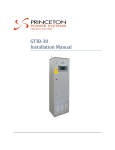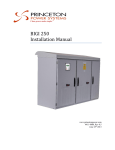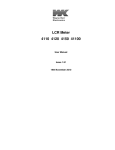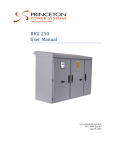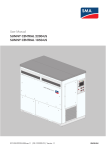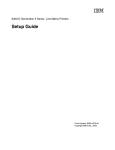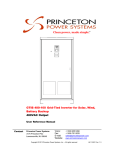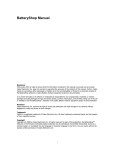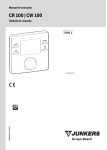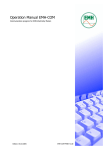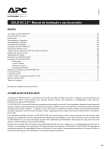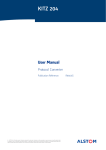Download DRI-10 Installation Manual
Transcript
Clean power made simple.™ DRI-10 Installation Manual www.princetonpower.com 4411-0005, Rev 1.4 February 27 , 2013 Copyright The statements and information in this document must not be changed without special notification from Princeton Power Systems Inc. Furthermore, Princeton Power Systems Inc. does not commit to any further obligations with this document. Use and reproduction is only permitted in accordance with the contractual agreements with Princeton Power Systems. Under no circumstances may parts of this publication be copied, reproduced, stored in a retrieval system or translated into another language, except with written permission from Princeton Power Systems, Inc. © Copyright 2013 Princeton Power Systems, Inc. 3175 Princeton Pike Lawrenceville, NJ 08648 Tel: 609-955-5390 Fax: 609-751-9225 Email: [email protected] Princeton Power Systems, and "Clean Power made simple" are registered trademarks of Princeton Power Systems, Inc. Specifications and descriptions in this document were in effect at the time of publication. Princeton Power Systems, Inc. reserves the right to change specifications, product appearance or to discontinue products at any time. No patent infringement liability is assumed by Princeton Power Systems, Inc. with regards to the use of information, circuits, equipment, or software described in this manual. The information contained in this manual is confidential and/or proprietary business or technical data. Unauthorized copying, distribution or use of this manual, in whole or in part, without receiving prior written consent from Princeton Power Systems, Inc. is strictly prohibited. About This Manual Purpose The purpose of this Installation Manual is to provide explanations and procedures for installing and troubleshooting the DRI-10 Scope This manual provides safety guidelines, detailed planning and setup information, procedures for installing the inverter, as well as information about troubleshooting the unit. It does not provide details about particular brands of batteries. Audience This manual is intended as guidance for installing the DRI-10. required to be certified technicians or electricians. Installers are About this Manual Organization This manual is organized into five chapters and two appendices. Chapters Chapter 1 welcomes the user and provides background information about the DRI-10 Inverter and Princeton Power Systems. Chapter 2 provides general information about the DRI-10 and introduces several of the important system components. This section can also be found in the user manual of the DRI-10. Chapter 3 provides important information regarding enclosure transport, placement and dimensions. Chapter 4 contains instructions on how to wire up the DRI-10. Chapter 5 provides a non-exhaustive wiring checklist and commissioning sequence for the DRI-10 inverter. Appendix A provides the technical specifications of the DRI-10. Appendix B, “Return Material Authorization, Product, and Contact Information” This chapter provides instructions for obtaining a Return Material Authorization, if the product needs to be returned to Princeton Power Systems or one of its authorized service centers. Abbreviations and Definitions The following table provides a glossary of technical terms used in this manual. The glossary also defines some common electrical terms and acronyms that may be used in this manual. Abbreviations 4411-0005, Rev 1.4 Definition AC Alternating Current ATS Automatic Transfer Switch CEC California Energy Commission DC Direct Current DPDT Double Pole Double Throw DRI Demand Response Inverter ESD Electro-Static Discharge GFDI Ground Fault Detector and Interrupter HMI Human/Machine Interface I/O Input/Output IEEE Institute for Electrical and Electronics Engineers iii About this Manual Abbreviations Definition MPPT Maximum Power Point Tracking NEC National Electric Code NEMA National Electrical Manufacturers Association PCB Printed Circuit Board PPS Princeton Power Systems PSU Power Supply Unit PV Photovoltaic SPDT Single Pole Double Throw SPST Single Pole Single Throw THD Total Harmonic Distortion UL Underwriters Laboratories VPC Volts Per Cell Important Safety Instructions SAVE THESE INSTRUCTIONS– This manual contains important instructions for the DRI-10 that shall be followed during installation and maintenance of the inverter. Symbols The following is a list of symbols used in this manual and on labels in the DRI-10 kW. DC circuit AC circuit Phase indicator Protective earth ground. Other grounding conductor. iv 4411-0005, Rev 1.4 About this Manual Warning Symbols used in this manual Attention: This symbol identifies information about circumstances or practices that could lead to personal injury, death, internal component damage, reduced product life, equipment damage, economic loss, or other adverse effects. Shock Hazard: This symbol identifies information about a condition or procedure that could be potentially lethal or harmful to personnel or damaging to components due to live voltages within the system, components holding stored energy, or electrostatic discharge (ESD). General Precautions Maintenance by Qualified Personnel: Only personnel familiar with the Princeton Power DRI-10 Inverter and associated machinery should attempt installation, commissioning, or maintenance of the system. Untrained or unauthorized personnel run the risk of grave personal injury, death, or equipment damage. These servicing instructions are for use by qualified personnel only. To reduce the risk of electric shock, do not perform any servicing other than that specified in the operating instructions unless you are qualified to do so. Use appropriate tools only and wear appropriate protective gear. Remove all conductive jewelry when working on the inverter (e.g. rings, watches and other metal objects). Ensure that all tools, paperwork, and other foreign objects not designed for use in the Inverter are removed from the enclosure prior to closing the door and re-energizing the equipment. High Voltage Electric Shock Hazard: The Princeton Power DRI-10 Inverter and equipment connected to it, contains electrical components carrying potentially lethal voltages and currents. Extreme caution should be exercised around the system, especially when the cabinet door is open. Before opening the cabinet, all supply power and loads, including all DC sources (batteries and PV arrays) should be disconnected externally using a standard physical lock-out procedure and the service personnel should wait 5 minutes prior to opening the enclosure door to allow internal components to discharge. Note that a PV array must always be disconnected when performing maintenance, even in no-light conditions. Avoid hazardous voltage situations that could result from unsafe conditions such as, but not limited to, the following: 4411-0005, Rev 1.4 Back-feed from the utility Improper grounding Handling electrical leads or devices with wet hands or on wet ground Frayed electrical leads Working with or on an electrically hot system or component, or when connected to an energized load An ungrounded battery pack Improper connection or re-connection of the terminal leads Short circuits Energized normal and emergency power sources v About this Manual Installation to Code: The following instructions are merely a guide for proper installation. The National Electric Codes (NEC), local codes, and similar standards outline detailed requirements for safe installation of electrical equipment. Installation must comply with specifications for wire types, conductor sizes, electrical and thermal insulation, branch circuit protection, grounding, and disconnect devices. Princeton Power Systems cannot assume responsibility for compliance or noncompliance to any national or local code. Princeton Power Systems cannot assume responsibility for personal injury and/or equipment damage exists if codes are ignored or misapplied during installation. CAUTION: To reduce the risk of fire, connect each AC circuit of the inverter only to a circuit provided with 50 amperes maximum branch-circuit over-current protection in accordance with the National Electrical Code, ANSI/NFPA 70. Improper Use: Princeton Power Systems cannot assume responsibility for personal injury and/or equipment damage as a result of improper installation, use, maintenance, reconfiguration, reprogramming, or other improper actions. An incorrectly serviced or operated Inverter system can cause personal injury, component damage, or reduced product life. Malfunction may result from wiring errors, an incorrect or inadequate DC supply or AC grid connection, excessive ambient temperatures or obstructed ventilation, or incorrect software configuration. Keep the door closed at all times when operating the system. Additionally, keep all guards, screens, and electrical enclosures in place when the system is operating. Close the inverter enclosure and put all guards and screens in place before energizing the unit. Heat Hazard: The cabinet should not be mounted on a combustible surface nor should combustible materials be placed on or against the cabinet. The system should not be installed in a confined space that prevents proper ventilation or allows the build-up of excessive heat. A minimum of 12 inches of spacing clearance must exist for proper cooling airflow into and out of ventilation openings. Keep vents and air outlets clear of debris and provide proper airflow. Do not place or store any objects on the enclosure roof ESD Sensitive Components: The inverter contains Electrostatic Discharge (ESD) sensitive components. Standard ESD control precautions must be followed when installing, commissioning, testing, servicing, or repairing the system. Component damage, component degradation, or an interruption in control system operation may occur upon an electrostatic discharge event. Use anti-static wristbands when servicing electronic components. Locked Doors: The inverter enclosure should remain locked at all times during normal operation and should only be unlocked for maintenance by qualified personnel. Enclosure keys should be stored in a safe place and should be accessible to appropriate personnel only. vi 4411-0005, Rev 1.4 About this Manual Electrical Connections: Be sure that all electrical connections and connectors are properly installed and connected with proper torque. Fuses: For continued protection against risk of fire, only use replacement fuses of the same type and rating as the original fuse. Replacing of fuses should be done by knowledgeable and trained personnel only. Safety Check Performing a routine safety check before energizing the Inverter will minimize the risk of injury to the operator and minimize the potential for damaging the unit. Before operating the unit, check for obvious signs of damage or concern. The following is a list of suggested items to be checked before operating the unit: 1. Check the enclosure for obvious signs of damage. 2. Verify that all inlet and outlet vents are clear of debris. 3. Check external wires and cables for signs of damage, such as fraying or cracked insulation. 4. Check room for potential hazards, such as standing water on the floor or on the DRI-10 Inverter. Note: Additional safety checks may be necessary depending on the particular installation of the unit. The safety checklist above is not intended to be all-inclusive. Resolve all issues before operating the inverter. Contact Princeton Power Systems if necessary. Terms of Use Because of the wide variety of uses for power electronics equipment, this manual does not describe every possible application or configuration. All technicians responsible for installing, commissioning, and operating this equipment must satisfy themselves of the suitability and proper implementation of the intended application of this power conversion product. In no event will Princeton Power Systems, Inc., its subsidiaries, partners, employees, or affiliates be responsible or liable for any damages, indirect or direct, resulting from the misuse or incorrect application of this equipment. The examples and diagrams in this manual are for illustrative purposes only. Because of the wide variety of uses, applications, peripheral equipment, and facility configurations particular to each installation, Princeton Power Systems, Inc. cannot assume responsibility or liability for actual use based on the information provided herein. 4411-0005, Rev 1.4 vii About this Manual Battery Information This system is designed to be operated with a variety of battery types and voltage. Installer must determine if the charging methods outlined in the User Manual Chapter 6 are compatible with the type of battery used. Battery voltage and current ratings must comply with the DC port ratings outlined in section 2.4.2 WARNING: The battery charge control function has adjustable battery charging settings. The user must confirm that the charge control profile used in this inverter is appropriate and safe for the type of battery used and that all battery charging settings are set correctly for the battery voltage, current, and temperature ratings. Setting these settings incorrectly may damage the battery and the inverter and may cause a hazardous condition that puts personnel at risk of grave injury or death. WARNING: Consult the battery manufacturer for information regarding safe transport, storage, operation and maintenance of batteries. Although this manual contains some information regarding battery safety but it is by no means exhaustive. viii 4411-0005, Rev 1.4 About this Manual This page intentionally left blank. 4411-0005, Rev 1.4 ix Contents About This Manual ................................................................................................................................ ii Purpose ...............................................................................................................................................ii Scope ii Audience .............................................................................................................................................ii Organization ......................................................................................................................................iii Abbreviations and Definitions ...........................................................................................................iii Important Safety Instructions................................................................................................................ iv Symbols ............................................................................................................................................. iv Warning Symbols used in this manual ................................................................................................ v General Precautions ............................................................................................................................ v Safety Check .....................................................................................................................................vii Terms of Use.....................................................................................................................................vii Battery Information..........................................................................................................................viii Introduction 15 1 1.1 Congratulations............................................................................................................................. 16 1.2 PPS Company information ........................................................................................................... 16 System Overview and Configurations 17 2 2.1 System Overview .......................................................................................................................... 18 2.1.1 2.1.2 2.1.3 2.1.4 Power Ports ............................................................................................................................ 18 Isolation Transformer ............................................................................................................. 19 Functional Power Block Diagram .......................................................................................... 20 Main System Components ..................................................................................................... 21 2.2 Power Format ............................................................................................................................... 25 2.2.1 Split Phase Power Format ...................................................................................................... 26 2.2.2 2-phase power format ............................................................................................................. 26 2.3 DRI-10 Configuration options ...................................................................................................... 26 2.3.1 Offgrid Configuration ............................................................................................................ 26 2.3.2 On-grid Configuration ............................................................................................................ 27 2.3.3 Isolation Transformer ............................................................................................................. 28 2.4 Important System Specifications .................................................................................................. 29 2.4.1 2.4.2 2.4.3 2.4.4 Load Port Specifications ........................................................................................................ 29 Grid Port Specifications ......................................................................................................... 30 Battery Port Specifications ..................................................................................................... 30 PV Port Specifications ........................................................................................................... 30 Pre-Installation 31 3 3.1 Unpacking, Inspection, and Storage ............................................................................................. 32 3.2 Dimensions ................................................................................................................................... 32 3.2.1 Outer Dimensions .................................................................................................................. 32 3.2.2 Pad Mounting ......................................................................................................................... 32 Contents 3.3 Inverter Placement Considerations ............................................................................................... 33 Wiring Instructions 37 4 4.1 Preparing for the Installation ........................................................................................................ 38 4.1.1 Installation Tools and Materials Tools Required ................................................................... 38 4.2 Safety ............................................................................................................................................ 38 4.3 External disconnect and overcurrent protection requirements ...................................................... 39 4.3.1 AC Disconnect switch requirements ...................................................................................... 39 4.3.2 DC disconnect switch requirements ....................................................................................... 39 4.4 Opening the enclosure .................................................................................................................. 40 4.4.1 Opening enclosure door ......................................................................................................... 40 4.4.2 Opening hinged HMI cover ................................................................................................... 41 4.4.3 Removing safety panels ......................................................................................................... 42 4.5 Wire Sizing and Ratings ............................................................................................................... 43 4.5.1 Power Wire Sizing and Ratings ............................................................................................. 43 4.5.2 Control Wire Sizing and Ratings ........................................................................................... 43 4.6 Wiring Terminals .......................................................................................................................... 44 4.7 Earth Wiring ................................................................................................................................. 45 4.7.1 4.7.2 4.7.3 4.7.4 4.7.5 AC Circuit and Battery Port earth wire requirements ............................................................ 45 PV DC Input .......................................................................................................................... 46 Grounding in off-grid configuration ...................................................................................... 46 Grounding in on-grid configuration ....................................................................................... 46 Connecting to the Grounding terminal ................................................................................... 46 4.8 Torque Specifications of Power Terminal Blocks ........................................................................ 47 4.9 Utility Grid Port Wiring................................................................................................................ 47 4.10 Load Port Wiring.................................................................................................................... 48 4.11 PV Port Wiring....................................................................................................................... 49 4.11.1 PV Port grounding ................................................................................................................. 49 4.12 4.13 4.14 Battery Port Wiring ................................................................................................................ 50 Example Power Wiring Diagrams .......................................................................................... 50 Signal wiring .......................................................................................................................... 52 4.14.1 Digital Inputs ......................................................................................................................... 52 4.14.2 Digital outputs ........................................................................................................................ 53 4.14.3 Battery Management System (BMS) Connection .................................................................. 54 4.14.4 Other Communication ports ................................................................................................... 55 Commissioning Sequences 57 5 5.1 Wiring Checklist ........................................................................................................................... 58 5.2 Commissioning Checklist ............................................................................................................. 59 DRI 10 kW Specifications 62 A A.1 System Specifications ................................................................................................................... 63 4411-0005, Rev 1.4 xi Contents Return Material Authorization, Contact, and Product B Information 65 B.1 Return Material Authorization Policy ......................................................................................... 66 B.2 Out of Warranty Service .............................................................................................................. 66 B.3 Contact Information ...................................................................................................................... 66 B.4 Information About This System .................................................................................................. 67 xii 4411-0005, Rev 1.4 Contents Figures Figure 1: Symbolic single line diagram of DRI-10. .................................................................................... 19 Figure 2: Symbolic representation of the DRI-10 with isolation transformer. ........................................... 20 Figure 3: Functional power diagram of the DRI-10.................................................................................... 21 Figure 4: Closed DRI-10 metal enclosure................................................................................................... 21 Figure 5: Touch Screen HMI mounted in front door of DRI-10 enclosure. ............................................... 22 Figure 6: View of DRI-10 enclosure when front door is opened. ............................................................... 22 Figure 7: Picture of DRI-10 control Panel showing disconnects in the open position. .............................. 23 Figure 8: DRI-10 integrated PSU fuses. ..................................................................................................... 24 Figure 9: Main User Power Terminal Blocks of DRI-10 in top part of enclosure. ..................................... 25 Figure 10: Single line diagram of DRI-10 inverter in off-grid configuration. ............................................ 27 Figure 11: Single line diagram of DRI-10 in on-grid configuration. .......................................................... 28 Figure 12: Position of the internal isolation transformer in the DRI-10 enclosure. .................................... 29 Figure 13: Outer dimensions of DRI-10 inverter ........................................................................................ 32 Figure 14: Bottom view of DRI-10 Enclosure showing position and dimensions of mounting holes........ 33 Figure 15: Mounting Pad Layout for DRI-10 Installation. ......................................................................... 33 Figure 16: DRI-10 Side view showing ventilation louvers. ........................................................................ 34 Figure 17: Enclosure with lockable handle. ................................................................................................ 40 Figure 18: Water proof HMI Cover ............................................................................................................ 41 Figure 19: DRI-10 Safety Panels ................................................................................................................ 42 Figure 20: View of Terminal block for DC (PV and Battery) and AC power wiring................................. 44 Figure 21: External wire routing for DRI-10 power connections ............................................................... 45 Figure 22: Main earth terminals (4) inside enclosure with earth wire connected. ...................................... 47 Figure 23: Grid port wiring connections. .................................................................................................... 47 Figure 24: Load port wiring connections. ................................................................................................... 48 Figure 25: PV port wiring connections. ...................................................................................................... 49 Figure 26: Battery port wiring connections. ............................................................................................... 50 Figure 27 Example power wiring diagram for DRI-10 installation in on-grid mode ................................. 51 Figure 28 DRI-10 Client I/O device with connection points of digital inputs highlighted. ........................ 53 Figure 29 Functional diagram of SPDT relay on optional DRI-10 client input/output PCB ...................... 54 Figure 30: Optional DRI-10 HMI Communications device with connection points of BMS marked. ...... 55 Figure 31: HMI Communication Device with location for USB connection. ............................................ 56 Figure 32: HMI Communications device showing position of the Ethernet RJ-45 receptacle. .................. 56 4411-0005, Rev 1.4 xiii Contents Tables Table 1: Summary of split-phase power format.......................................................................................... 26 Table 2: Summary of two-phase power format........................................................................................... 26 Table 3: Electrical specifications of DRI-10 Load port. ............................................................................. 29 Table 4: Electrical specifications of the Utility Grid port of the DRI-10. .................................................. 30 Table 5: Electrical specifications of Battery Port. ...................................................................................... 30 Table 6: Electrical specifications of DRI-10 PV Port. ................................................................................ 30 Table 7: Digital output relay contact specifications of the optional DRI-10 Client I/O device. ................. 54 Table 8: DRI-10 Key Specifications. .......................................................................................................... 63 xiv 4411-0005, Rev 1.4 1 Introduction DRI-10 Installation Manual 1.1 Congratulations Congratulations on purchasing one of the most advanced inverters in the world, from one of the leading power electronics companies in the world. The DRI-10 Inverter meets Underwriter’s Labs’ standard 1741 to allow power export to the North American electric grid. It can also power loads directly, and can automatically transfer to off-grid mode when the electric grid goes down. It is compatible with multiple input sources, including solar arrays with advanced maximum power point tracking (MPPT), battery banks, and generators. The DRI-10 is highly reliable, efficient, and flexible. It is backed by a world-class team of engineers at Princeton Power Systems that can ensure the technical and financial success of your application. 1.2 PPS Company information Princeton Power Systems designs and manufactures advanced power conversion products and systems to provide customers with cost-effective, reliable, smart distributed generation. Our patented technologies, including AC-linkTM, produce clean electric power simply and efficiently, and our capable and flexible engineering team works closely with our customers to solve their problems. Customer solutions include grid-integrated distributed generation, renewable energy, energy storage, and military power supplies for Navy and Army applications. 16 4411-0005, Rev 1.4 DRI-10 Installation Manual-UL 2 4411-0005, Rev 1.4 System Overview and Configurations 17 DRI-10 Installation Manual 2.1 System Overview The DRI-10 is an extremely versatile state of the art multi-port energy management converter system. The DRI-10 can be connected to batteries, solar PV arrays, generators, utility grids and can supply local loads. Unlike most conventional inverters and renewable energy systems, the DRI-10 is designed to support and strengthen the utility grid instead of being a burden on it. It is therefore compatible with next generation smart and micro grids. These new power systems enable a much higher penetration of renewable energy than conventional inverter systems would allow and therefore the DRI-10 helps to facilitate technical solutions to some of the world’s most urgent environmental problems. In an on-grid application, the loads connected to the DRI-10 Load Port are supplied directly from the utility (as long as the grid is available). The DRI-10 charges its batteries from the utility grid if not enough solar PV energy is available to do so. When the batteries are full, the DRI-10 supplies all available solar PV energy to the loads. If there is more solar PV energy available than required by the Load Port, this energy flows into the utility grid (if power export is enabled). At any stage, the utility grid can request the DRI-10 to provide additional energy and supplement the utility grid by feeding additional energy from the batteries into the grid. The DRI-10 can also be used in off-grid applications. The goal in such applications is to supply reliable, clean and cost-effective power to loads that cannot be supplied directly from the utility grid. In such applications, the DRI-10 uses solar PV energy to supply local loads. By using the energy storage capacity of batteries, the DRI-10 is able to provide a reliable and constant power source from inherent intermittent solar PV energy. The DRI-10 also allows solar PV energy to be supplemented with combustion generators and other AC sources and is able to intelligently control and manage these multiple energy sources. 2.1.1 Power Ports The DRI-10 Inverter has two DC ports (battery and PV) and two AC power ports (grid and load) giving the DRI-10 a total of four power ports. In this manual, the DRI-10 is often symbolically represented by a square where each of these four ports is represented by one side of the square. This symbolic representation of the DRI-10 is shown in the center of Figure 1. 1 2.1.1.1 Battery Port The battery port is a two wire DC port used to connect a battery bank to the DRI-10. 2.1.1.2 PV Port The PV Port is a two wire DC port used to connect a PV array to the DRI-10. 2.1.1.3 Load Port The load port is a three wire AC port with two phases and a neutral line. This port is used to connect local loads to the DRI-10. Optionally, suitable AC generators can also be attached to this port. 18 4411-0005, Rev 1.4 DRI-10 Installation Manual-UL 2.1.1.4 Grid Port The grid port is a three wire AC port with two phases and a neutral line. This port can be connected to the utility grid. If no utility grid is available, suitable AC generators can also be connected to this port. Utility Grid Bat Load Grid Grid PV DRI-10 Inverter Battery Bank Local Loads PV Array Figure 1: Symbolic single line diagram of DRI-10. 2.1.2 Isolation Transformer The DRI-10 comes equipped with an internal isolation transformer. The isolation transformer provides electrical isolation between the DC and AC ports. The isolation transformer does not provide electrical isolation between the two DC ports. The isolation transformer also does not provide electrical isolation between the two AC 4411-0005, Rev 1.4 19 DRI-10 Installation Manual ports. Bat Load Grid Grid PV Isolated Figure 2: Symbolic representation of the DRI-10 with isolation transformer. 2.1.3 Functional Power Block Diagram A functional block diagram of the DRI-10 power circuit is shown in Figure 3. This diagram provides information to the interested reader but does not need to be understood for successful installation. The DRI-10 consists of two DC-DC converter stages and a single DC-AC stage. An internal manual utility disconnect switch is provided. This internal circuit breaker switch is not the same as an external utility grid disconnect switch. Internal disconnect switches are provided on both the battery and PV ports. These are not the same as the external disconnect switch. Figure 3 also provides an overview of the grounding arrangements of the DRI-10. A special PV ground terminal is provided which is tied to the utility and load port ground internally after passing through an internal GFDI device. 20 4411-0005, Rev 1.4 DRI-10 Installation Manual-UL PV+ Integrated Manual PV Disconnect Bat- Automatic contactors internal isolation transformer Bat+ CB2 Integrated Manual Utility Disconnect Automatic contactors CB1 Integrated Manual Bat Disconnect DRI-10 Inverter U1 U2 UN Ugnd Lgnd L1 L2 LN PVPVgnd GFDI Current Sensor Figure 3: Functional power diagram of the DRI-10. 2.1.4 Main System Components Some of the main system components are introduced in this section. Only system components that are relevant for the installation are mentioned. Please refer to other DRI-10 documentation for information regarding other system components. 2.1.4.1 Enclosure The DRI-10 is housed inside a NEMA 3 rated metal enclosure as shown in Figure 4. Instructions on how to open and close the enclosure, dimensions, placement and further enclosure related information are provided in sections 3.2 and 3.3. Figure 4: Closed DRI-10 metal enclosure. 4411-0005, Rev 1.4 21 DRI-10 Installation Manual 2.1.4.2 Human Machine Interface (HMI) The DRI-10 is controlled via a state of the art touch screen HMI which is installed on the front door of the DRI-10 metal enclosure. The HMI is covered by a separate hinged cover to protect it from water and other environmental factors. Instructions on how to open and close the hinged HMI cover are provided in section 4.4.2. Figure 5: Touch Screen HMI mounted in front door of DRI-10 enclosure. 2.1.4.3 Safety Panels Once the enclosure front door is opened, the user has access to several switches and breakers on a control panel. The rest of the internal system components are covered by two safety panels. Integrated disconnects and breakers Figure 6: View of DRI-10 enclosure when front door is opened. 22 4411-0005, Rev 1.4 DRI-10 Installation Manual-UL 2.1.4.4 Integrated Grid Disconnect The DRI-10 contains an integrated circuit breaker that can be used to connect and disconnect the Grid Port from parts of the DRI-10 system. The electrical position of this three phase circuit breaker is shown in the functional power block diagram in Figure 3 in section 2.1.3. This breaker is open when the switch is in down position (as shown in Figure 7) and closed when the breaker is in the up position. Grid Battery Control Power Disconnect Disconnect Fuses GFDI PV Disconnect Fuse Figure 7: Picture of DRI-10 control Panel showing disconnects in the open position. 2.1.4.5 Integrated Battery Disconnect The DRI-10’s integrated battery disconnect switch is shown in Figure 7. The electrical position of this breaker is shown in the functional power block diagram in Figure 3 in section 2.1.3. This breaker is open (disconnected) when in the down position as shown in Figure 7. The integrated battery disconnect switch must always be in the off (disconnected or down) position before the external battery disconnect switch is closed. Failure to do so will cause severe damage to the DRI-10. The DRI-10 is equipped with a precharge circuit that is always on. This means that the DC bus is always charged as long as the external disconnect is closed! External overcurrent is required on Battery Port. (63 Amps Max) 2.1.4.6 Integrated PV Disconnect The DRI-10’s integrated PV disconnect switch is shown in Figure 7. The electrical position of this breaker is shown in the functional power block diagram in Figure 3 in section 2.1.3. This breaker is open (disconnected or off) when in the down position as shown in Figure 7 and in the closed (connected or on) position when up. External overcurrent is required on PV Port. (63 Amps Max) 2.1.4.7 Integrated Control Power Disconnect Fuses The DRI-10’s integrated Control Power Supply Disconnect fuses are shown in Figure 7. These fuses can be used to remove power to the HMI and other control systems. The fuse location is shown in Figure 7. The fuse switch must be pushed in to close it 4411-0005, Rev 1.4 23 DRI-10 Installation Manual to the position shown in Figure 8 . Figure 8: DRI-10 integrated PSU fuses. 2.1.4.8 Safety Panels To access the internals of the DRI-10, the two protective safety panels shown in Figure 6 must be removed. Instructions for removing these panels are provided in section 4.4.3. Never attempt to remove the safety panels while the DRI-10 is running or any external disconnect switches are still closed. Wait at least five minutes after opening the last of the four external disconnect switch (grid port, load port, battery port and PV port) before proceeding to remove the safety panels. 2.1.4.9 Main User Power Terminal Blocks Once the top safety panel is removed, the user can access the main power connection terminals of the DRI-10. These terminals are shown in Figure 9. 24 4411-0005, Rev 1.4 DRI-10 Installation Manual-UL Figure 9: Main User Power Terminal Blocks of DRI-10 in top part of enclosure. ** Terminal blocks are only accessible when top safety panel is removed. 2.2 Power Format The DRI-10 inverter AC ports work with a two phase power format. Both AC ports have three wires, two live wires and one neutral wire. The DRI-10 is compatible with a conventional split phase 240V supply power format. By measuring the voltages between any three power wires using a multimeter and comparing them to the values in Table 1 and Table 2 it is possible to verify if the power format being used is 240V split phase or 2-phase power format. The DRI-10 does not support 2-phase power format at this time. 4411-0005, Rev 1.4 25 DRI-10 Installation Manual 2.2.1 Split Phase Power Format In this power format, the two phases are 180 degree phase shifted with a magnitude of 120Vrms each and a frequency of 60Hz. This power format is summarized in Table 1. Table 1: Summary of split-phase power format. Frequency Phase1 to Neutral Voltage Phase2 to Neutral Voltage Phase1 to Phase2 Voltage 60Hz 120Vrms 120Vrms 240Vrms 2.2.2 2-phase power format In this power format, the two phases are 120 degrees phase shifted with a magnitude of 120Vrms each and a frequency of 60Hz. This power format is summarized in Table 2. Table 2: Summary of two-phase power format. Frequency Phase1 to Neutral Voltage Phase2 to Neutral Voltage Phase1 to Phase2 Voltage 60Hz 120Vrms 120Vrms 207.8Vrms 2.3 DRI-10 Configuration options This section provides a brief overview of how the DRI-10 can be connected to other system components. For more detailed information, please refer to Chapter 4. 2.3.1 Offgrid Configuration 2 In the simplest configuration, the DRI-10 can be run in pure off-grid mode. In this mode, the Grid-port is not utilized. The off-grid configuration is shown schematically in Figure 10. The internal wiring of the load port (L1, L2, LN) is shown in Figure 3. 26 4411-0005, Rev 1.4 DRI-10 Installation Manual-UL Bat Load Grid Grid Battery Bank PV DRI-10 Inverter Local Loads PV Array Figure 10: Single line diagram of DRI-10 inverter in off-grid configuration. 3 1 2 2.3.2 On-grid Configuration The on-grid configuration is similar to the pure off-grid configuration except for the additional connection of the utility grid to the grid port. If grid is available less than 100% of the time, a suitable AC generator can also be connected to the grid port. Alternatively, both a utility and an AC generator can be connected to the grid port if an additional Automatic Transfer Switch (ATS) is installed to switch between generator and grid. It is highly recommended that an external bypass switch is installed which is interlocked with the external grid and load disconnect. 4411-0005, Rev 1.4 27 DRI-10 Installation Manual Utility Grid and/or AC Generator Bat Load Grid Grid Battery Bank PV DRI-10 Inverter Local Loads External PV disconnect PV Array Figure 11: Single line diagram of DRI-10 in on-grid configuration. 2.3.3 Isolation Transformer The DRI-10 includes an isolation transformer. The transformer provides electrical isolation between the AC and DC ports as explained in section 2.1.2 and allows grounding of the DC ports. The position of the transformer in the DRI-10 enclosure is shown in Figure 12. 28 4411-0005, Rev 1.4 DRI-10 Installation Manual-UL Figure 12: Position of the internal isolation transformer in the DRI-10 enclosure. 2.4 Important System Specifications This section highlights the most important specifications of the DRI-10 that must be taken into careful consideration for system sizing and might be useful during the installation process. 2.4.1 Load Port Specifications Electrical parameters of the DRI-10 load port are shown in Table 3. Table 3: Electrical specifications of DRI-10 Load port. Voltage Frequency Total Power Rating Real Power Rating 4411-0005, Rev 1.4 240V (Line-Line) (see section 2.2) +10%/-12% 60Hz (57Hz – 63Hz) 6.25kVA per phase (12.5 kVA total) with 150% overload for 10 seconds with 10 minute duty cycle. 5kW per phase (10kW) with 150% overload for 10 seconds with 10 minute duty cycle. 29 DRI-10 Installation Manual 2.4.2 Grid Port Specifications Electrical specifications of the DRI-10 utility grid port are shown in Table 4. Table 4: Electrical specifications of the Utility Grid port of the DRI-10. Voltage Frequency Real Power Rating Reactive Power Rating (per phase) 240V (Line-Line) (see section 2.2) +10%/-12% 60Hz (57Hz – 63Hz) 10kW (with 150% overload for 10 seconds with 10 minute duty cycle) for energy flow to Load or Battery Port. 10kW for power export. 2.5kVAR @ 5kW, 3.9kVAR @ 4kW, 4.75kVAR @ 3kW, 5kVAR @ 2.5kW 2.4.3 Battery Port Specifications Electrical specifications of the DRI-10 battery port are shown in Table 5. Table 5: Electrical specifications of Battery Port. Power Rating 10kW with 150% overload for 10 seconds with 10 minute duty cycle. 150V – 600V Input Voltage Range 2.4.4 PV Port Specifications Electrical specifications of the PV Port are summarized in Table 6. Table 6: Electrical specifications of DRI-10 PV Port. Power Rating Input Voltage Range Maximum Power Voltage Range 30 10kW 150V – 600V 300V – 600V 4411-0005, Rev 1.4 DRI-10 Installation Manual-UL 3 4411-0005, Rev 1.4 Pre-Installation 31 DRI-10 Installation Manual 3.1 Unpacking, Inspection, and Storage Upon receiving the unit, inspect for signs of damage that may have been caused during shipping. If damage is found, immediately contact Princeton Power Systems and the Shipping Company. The inverter weighs approximately 800 lbs (350 kg). Use a forklift or pallet jack to move the unit. Do not attempt to lift and/or move the inverter by hand. Attempting to move the unit by hand may lead to serious injury. 3.2 Dimensions 3.2.1 Outer Dimensions The outer dimensions of the DRI-10 unit are shown in Figure 13. Figure 13: Outer dimensions of DRI-10 inverter 3.2.2 Pad Mounting The DRI-10 must be anchored to the floor. Mounting holes are located in the mounting feet of the DRI-10 The exact positioning of the mounting holes is shown in Figure 14. 32 4411-0005, Rev 1.4 DRI-10 Installation Manual-UL Figure 14: Bottom view of DRI-10 Enclosure showing position and dimensions of mounting holes. Figure 15: Mounting Pad Layout for DRI-10 Installation. 3.3 Inverter Placement Considerations Although the DRI-10 inverter is designed to be as efficient as possible, some heat is inevitably generated by the unit. The DRI-10 needs to be installed in such a manner that hot air generated by the unit can escape. 4411-0005, Rev 1.4 33 DRI-10 Installation Manual The entire enclosure is used to dissipate waste heat. At high power, the temperature of the entire enclosure will therefore increase significantly. Hot spots on the enclosure may reach up to 140 degrees Fahrenheit (60 ºC). Ensure that no temperature sensitive objects are close to or touching any part of the inverter enclosure at any time. Also ensure that small children are unable to access the area where the inverter is stored. Hot air is designed to escape from the inverter through the ventilation louvers on the left side of the inverter which is shown in Figure 16. Figure 16: DRI-10 Side view showing ventilation louvers. For optimal performance, please ensure that these ventilation louvers are not blocked by surrounding objects or walls. Under no circumstances, should the left side of the inverter be moved directly up against a wall or other object. This will prevent air flow through the ventilation louvers and will also prevent the enclosure door from opening. For optimal performance, it is recommended to leave as much open space around the inverter as possible for optimal natural cooling. The minimum space requirement around the DRI-10 inverter for full power capability is 12 inches. The following is a list of the above requirements and other considerations that should be taken into account in order to get the most out of the DRI-10 inverter: 1. Mount the enclosure away from heat sensitive equipment and/or objects, since the enclosure heats up considerably during operation 2. Ensure that the ventilation louvers on the left of the enclosure are not obstructed. 3. Ensure that the enclosure is free standing and the space requirements are complied with. 4. The enclosure is NEMA 3 rated and can be installed INDOORS or OUTDOORS. 34 4411-0005, Rev 1.4 DRI-10 Installation Manual-UL 5. The maximum life of the inverter can be achieved by mounting the unit in a clean, dry and cool location 6. For optimal inverter life and performance, do not mount the inverter in direct sunlight, especially in hot climates. 7. The installation location should be sufficiently ventilated to prevent the inverter heat output from increasing the ambient temperature beyond the inverter’s rating. 8. Under certain operating conditions, the inverter will emit audible noise; it is not advisable to install in the immediate vicinity of living quarters. 9. The inverter should not be installed in an area that is excessively dusty, as this may decrease the performance of the air cooling system. 10. The inverter must not be installed in areas in which dust containing conductive particles (e.g. iron filings) may form. 11. When installing the inverter, care should be taken to ensure that the display unit remains at or below eye level. 12. Provisions should be made and/or procedures should be in place to ensure that nothing is placed or stored to the left of the enclosure that could block the ventilation louvers or prevent the enclosure door from being opened. 13. The inverter weighs about 800 lbs. Verify load capacity of mounting area. 14. Never mount the inverter any other way but upright. 4411-0005, Rev 1.4 35 DRI-10 Installation Manual This page intentionally left blank. 36 4411-0005, Rev 1.4 4 Wiring Instructions DRI-10 Installation Manual-UL 4.1 Preparing for the Installation 4.1.1 Installation Tools and Materials Tools Required 1. Wire strippers 2. Assorted open-end wrenches or socket wrench set and fittings 3. Torque wrench 4. Electrical tape 5. Multi-meter (AC/DC Voltage up to 600V) 6. Assorted Phillips screw drivers 7. Allen/Hex head driver set (through 1/2") 8. Slotted screw driver 9. Level 10. Pencil 11. Utility knife The following materials may be required for completing this installation: 1. Conduits (code compliant conduit is recommended), bushings, wire nuts, appropriate fittings for wire run, and seals as necessary. 2. Electrical wire of appropriate size and length 3. Breaker panels (if used) 4. Additional circuit breakers (if required) 5. Ground busses, bars, and/or rods 4.2 Safety WARNING: Shock Hazard: Ensure that all four ports are disconnected from the unit via external disconnect switches before performing any maintenance or installation. Ensure that no port can be reconnected during installation or maintenance by employing standard lock out procedures. Please note that the load port must also be disconnected since other power sources might connected to the load port. Wait at least 15 minutes after disconnection before commencing with work on the unit. Failure to comply with the above requirements could cause serious injury or death. A warning label is provided to inform all personnel that multiple sources of power are available inside. This label is installed on the outside of the door and should remain clearly visible. Ensure all sources are disconnected before servicing. 38 4411-0005, Rev 1.4 DRI-10 Installation Manual-UL Before connecting the solar panels, check that the voltage specified by the manufacturer corresponds to the actual measured voltage. At an outside temperature of -10°C1, the open-circuit voltage for the solar panels should never rise above 600 V. When the temperature is lower, the open-circuit voltage generated will be higher than normal. The temperature coefficients for calculating the open-circuit voltage at -10°C can be found in the data sheet for the solar panels. If the open-circuit voltage for the solar panels rises above 600 V, this may result in damage to the inverter and all warranty rights shall be declared null and void. Damage to the inverter may cause a hazardous condition that puts personnel at risk of grave injury or death. WARNING: The battery charge control function has adjustable battery charging settings. The user must confirm that the charge control profile used in this inverter is appropriate and safe for the type of battery used and that all battery charging settings are set correctly for the battery voltage, current, and temperature ratings. Setting these settings incorrectly may damage the battery and the inverter and may cause a hazardous condition that puts personnel at risk of grave injury or death. Grounding: All input and output circuits are isolated from the enclosure. System grounding, when required by Sections 690.41, 690.42, and 690.43 of the National Electric Code (NEC), ANSI/NFPA 70, is the responsibility of the installer. 4.3 External disconnect and overcurrent protection requirements For safe installation, operation and maintenance, it is recommended that external disconnect switches are installed on all four ports of the DRI-10. It is highly recommended that all disconnect switches are installed in a single neat enclosure or bypass box in close proximity to the DRI-10 inverter. All switches inside the bypassbox should be appropriately labeled and the necessary warning labels must be included. Circuit breakers can be used as disconnect switches. These then provide both over current protection and also function as disconnect switches. Note that DC disconnect switches must be used on the DC ports. External overcurrent is required on both Battery and PV Ports. (63 Amps Max) 4.3.1 AC Disconnect switch requirements The disconnect switches on the utility grid and load port as well as any bypass switches need to break both phases and leave the neutral unbroken to be fully compliant with NEC requirements. 4.3.2 DC disconnect switch requirements Both the battery port and the PV port must be equipped with two pole devices that enable disconnection of both the positive and negative conductor. In most cases, the combiner box of the PV array will provide this capability for the PV port. Many 1 39 In extreme locations, it might be necessary to use even lower temperature value. Contact Princeton Power System if you are using a PV system in extremely cold but sunny conditions. 4411-0005, Rev 1.4 DRI-10 Installation Manual-UL battery banks will also provide a disconnect device in which case another external disconnect device on the battery port is not needed. 4.4 Opening the enclosure 4.4.1 Opening enclosure door The DRI-10 enclosure front door is locked by a single lockable handle, shown in Figure 17. The handle has provision for a pad lock and is only to be unlocked by a qualified electrician or technician who is performing the installation or period maintenance. Once the pad lock is unlocked and removed, the handle needs to be rotated counter clockwise by 90 degrees to enable the front enclosure door to be opened. Figure 17: Enclosure with lockable handle. 40 4411-0005, Rev 1.4 DRI-10 Installation Manual-UL 4.4.2 Opening hinged HMI cover Figure 18: Water proof HMI Cover The HMI is protected by a waterproof cover as shown in Figure 18. To open this cover to access the HMI insert a screwdriver in the two black screw heads shown in the upper right and lower right of the cover door and turn counterclockwise to release. Swing door out after unlocking. 41 4411-0005, Rev 1.4 DRI-10 Installation Manual-UL 4.4.3 Removing safety panels Figure 19: DRI-10 Safety Panels The DRI-10 has two Plexiglas safety panels (shown in Figure 19) that cover the High Voltage and Low voltage sections of the DRI-10. These panels should only be removed by a certified technician or electrician, only after the DRI-10 has been in the de-energized state for at least 15 minutes. They can be removed by removing the screws along both sides of the panels. 42 4411-0005, Rev 1.4 DRI-10 Installation Manual-UL 4.5 Wire Sizing and Ratings All wiring installed in the system must be rated for 600VAC, including control and signal wiring. Installation to Code: The following instructions are merely a guide for proper installation. The National Electric Codes (NEC), local codes, and similar standards outline detailed requirements for safe installation of electrical equipment. Installation must comply with specifications for wire types, conductor sizes, electrical and thermal insulation, branch circuit protection, grounding, and disconnect devices. Princeton Power Systems cannot assume responsibility for compliance or noncompliance to any national or local code. Princeton Power Systems cannot assume responsibility for personal injury and/or equipment damage exists if codes are ignored or misapplied during installation. 4.5.1 Power Wire Sizing and Ratings All AC and DC power and earth wiring, including grid port, load port, PV port and battery port, should meet the following specifications: Table 7: Power port wire requirements Voltage Rating 600 Volts or greater per NEC Temperature Class 75°C or greater per NEC Gauge Copper: 6 AWG or greater per NEC Also refer to section 4.7 for ground wire requirements. 4.5.2 Control Wire Sizing and Ratings The tables in this section provide a guideline for wire types that should be used for the different types of signal and control wiring. 4.5.2.1 Analog, Digital I/O and temperature sensor wiring Refer to section 4.14.1 and 4.14.2 for more information. Table 8: User I/O wire requirements 43 Voltage Rating 600 Volts Temperature Class 75°C or greater Gauge Copper Stranded: 22 - 18AWG Cable type Shielded twisted pair recommended 4411-0005, Rev 1.4 DRI-10 Installation Manual-UL 4.5.2.2 Synchronization and Ethernet Wiring Also refer to section 4.14.4.2. Table 9: Ethernet port wire requirements Voltage Rating 600 Volts Temperature Class 75°C or greater Cable type Standard 8 way Ethernet cable: shielding recommended 4.6 Wiring Terminals All cables enter and exit the enclosure from underneath the plinth in the left front of the enclosure (see Figure 21). There are power cables for AC power wiring, DC power wiring and signal wiring respectively. A view of the power terminals is shown in Figure 20. Earth Ground Grid Phase 1 Grid Phase 2 Grid and Load Neutral Load Phase 1 Load Phase 2 Battery Connections PV Connections Figure 20: View of Terminal block for DC (PV and Battery) and AC power wiring 44 4411-0005, Rev 1.4 DRI-10 Installation Manual-UL External Wiring Figure 21: External wire routing for DRI-10 power connections 4.7 Earth Wiring It is essential that the DRI-10 is connected to protective earth ground of the premises. The DRI-10 provides a special terminal for this connection (see Figure 22). Once this terminal is earthed, the internal wiring of the DRI-10 will ensure that all parts of the enclosure and other touchable metal parts are properly shorted to the protective earth ground. It is the responsibility of the installer to ensure that all grounding arrangements are NEC compliant before proceeding with the installation. PPS takes no responsibility for damage or injuries resulting from non NEC compliant grounding arrangements. 4.7.1 AC Circuit and Battery Port earth wire requirements For the AC circuits and the battery port, a ground wire will be sized at least according to Table 1, based on the size of the over-current device protecting that circuit. Voltage and temperature requirements of section 4.5.1 must also be considered. 45 4411-0005, Rev 1.4 DRI-10 Installation Manual-UL Table 10: Ground Wire Size Chart 4.7.2 PV DC Input The ground wire for the PV port will be rated for at least 1.25 times the rated shortcircuit current of the installed PV array. 4.7.3 Grounding in off-grid configuration If the DRI-10 is to be installed in an off grid configuration, no protective earth connection might be available on the premises. In such an instance, an earth spike must be installed by qualified personnel. This earth connection must be fully compliant with all NEC requirements. If a protective earth is already available on the premises, NEC compliance of the existing grounding arrangement should be verified by qualified personnel. 4.7.4 Grounding in on-grid configuration If a grid is available on the premises, a protective earth connection must also already be available on the premises. The grounding arrangements of the premises must be checked for NEC compliance by qualified personnel before continuing with the installation. Note that it is generally not permissible to have separate earth connections on the same premises that are not electrically connected. Therefore, generally if a utility grid is available on the premises, the earth connection of that connection must be used. 4.7.5 Connecting to the Grounding terminal Connect the DRI-10 to the protective earth connection by feeding a green and yellow 46 4411-0005, Rev 1.4 DRI-10 Installation Manual-UL earth wire (specified in section 4.5.1 and 4.7.1) with the AC wires. Connect it to the earth terminal as shown in Figure 22. Earth Ground Terminal Blocks Figure 22: Main earth terminals (4) inside enclosure with earth wire connected. 4.8 Torque Specifications of Power Terminal Blocks All power wiring is done using the terminal blocks shown in Figure 20. The terminal blocks can accommodate 18-6 AWG wire. The Earth Ground terminal blocks can accommodate 14-4 AWG. During the wiring, all of the terminal block clamps should be tightened to 1.2-1.4 Nm / 10.6-12.4 Ib.in. 4.9 Utility Grid Port Wiring If the DRI-10 is to be used in an on-grid configuration, the utility grid must be connected to the unit. Wire requirements for this wiring are provided in section 4.5.1. Ensure that the utility is disconnected when connecting utility wires. Never attempt to connect live wires. Use standard lockout procedures to ensure the utility supply cannot be reconnected during installation. The three utility wires must be fed into the enclosure. Once inside the enclosure, the utility wires must be connected to the top three terminal blocks marked as U1, U2 and N as shown below. Figure 23: Grid port wiring connections. 47 4411-0005, Rev 1.4 DRI-10 Installation Manual-UL Wires should be stripped a minimum of .55” (14mm) before inserting into terminal blocks. It is important to ensure that the neutral wire is connected to N and not U1 or U2. A multi-meter and Table 1 or Table 2 can be used to determine which wire is the neutral wire should this information not be available. Ensure that supply is disconnected again after measurements are made before continuing with installation. 4.10 Load Port Wiring Run three wires that are rated in accordance with section 4.5.1, from the load port disconnect switch (see Figure 1) to the DRI-10 terminal blocks as shown. Figure 24: Load port wiring connections. During the wiring all of the terminal block clamps should be tightened to 1.2-1.4 Nm / 10.6-12.4 Ib.in. Wires should be stripped a minimum of .55” (14mm) before inserting into terminal blocks. Ensure that wires are not live and remain disconnected during installation. Never assume that there are no other sources connected to the load port. 48 4411-0005, Rev 1.4 DRI-10 Installation Manual-UL Ensure that neutral wire is correctly connected to N, phase 1 wire is connected to L1 and phase 2 wire is connected to L2. This is particularly important if the installation forms part of a larger installation where other energy sources might be connected to the load port. 4.11 PV Port Wiring Run two wires that are rated in accordance with section 4.5.1 from the PV port disconnect switch or PV array combiner box to the PV- and PV+ terminal blocks inside the DRI-10 as shown. Figure 25: PV port wiring connections. During the wiring all of the terminal block clamps should be tightened to 1.2-1.4 Nm / 10.6-12.4 Ib.in. Wires should be stripped a minimum of .55” (14mm) before inserting into terminal blocks. It is essential that the polarity of the PV array is correct. Use a multi-meter to check polarity of PV array if unsure. Ensure that PV array is disconnected again after measurements before proceeding with installation. 4.11.1 PV Port grounding All PV array frames should be grounded appropriately. The grounding wire of the PV frames should be done via the Earth Ground terminal shown in Figure 22. Connecting the PV array to a different ground point will bypass the GFDI unit in the DRI-10 and is not recommended. The DRI-10 has an integrated isolation transformer installed allowing for external grounding of the PV negative. When grounding the negative PV conductor, the 49 4411-0005, Rev 1.4 DRI-10 Installation Manual-UL battery negative conductor will also automatically be grounded since the PV negative and Battery negative are tied together inside the DRI-10 (see Figure 3). 4.12 Battery Port Wiring Run two wires, that are rated in accordance with section 4.5.1 from the battery port disconnect switch to the BT+ and BT- terminal blocks inside the DRI-10 (shown in Figure 26) via the DC conduit. DC wires and AC wires are not allowed to run in the same conduit. Figure 26: Battery port wiring connections. It is essential that the polarity of the battery is correct. Use a multi-meter to check polarity of battery if unsure. Ensure that battery is disconnected again after measurements before proceeding with installation. 4.13 Example Power Wiring Diagrams Figure 27 shows an example wiring diagram of a DRI-10 installation in on-grid mode. Since the DRI-10 includes an isolation transformer, the negative PV port can be grounded. The PV and battery negative terminals are tied together inside the inverter (see Figure 3) and grounding the negative PV port automatically grounds the negative battery port. 50 4411-0005, Rev 1.4 DRI-10 Installation Manual-UL 1 N 2 Gnd 1 N 2 Gnd Local Loads Load Grid BT+ BT- Bat + - External battery disconnect Gnd U1 UN U2 Bypass Box Utility Grid L1 LN L2 PV PV Array PV String Combiner Box PVGnd PV+ PV- Battery Bank Figure 27 Example power wiring diagram for DRI-10 installation in on-grid mode (** with integrated isolation transformer and grounded DC ports) 51 4411-0005, Rev 1.4 DRI-10 Installation Manual-UL 4.14 Signal wiring 4.14.1 Digital Inputs The DRI-10 has up to five dedicated digital inputs if the optional DRI-10 Client I/O device is installed. Provision can be made for additional inputs should this be required. Please contact PPS in this regard. Of the five standard inputs on the DRI-10 Client I/O device, three are reserved as feedback signals for the digital outputs of the DRI-10. If feedback signals for the outputs are not required, these can be used as additional independent digital inputs. The digital inputs work on 24V logic and are optically isolated from the rest of the system. A 24V power supply is available on the DRI-10 Client I/O device should it be required (available on J12 connector of DRI-10 Client I/O device). The polarity of the input is not important. Maximum current drawn by each input at 24V is 60mA while the expected current consumption is below 20mA. The digital input parameters of the optional DRI-10 Client I/O device are summarized in Table 1. Table 11: Digital Input parameters of DRI-10 Client I/O device. Input High Input Low Maximum current drawn (at 24V) Expected current drawn (at 24V) Polarity 24V 0V 60mA <20mA Either The input signals must be wired into J8, J10 and the top two pins of J1, J4 and J6 connectors on the optional DRI-10 Client I/O device which are listed in Table 11. The position of all connectors is highlighted in Figure 28. Table 12: Digital input connectors on optional DRI-10 Client I/O device. Description Dedicated digital input 4 Dedicated digital input 5 Digital input assigned to digital output 1 Digital input assigned to digital output 2 Digital input assigned to digital output 3 Connector J8 J10 J1 J4 J6 Please contact PPS for assistance in configuring specific functions for these digital inputs. 52 4411-0005, Rev 1.4 DRI-10 Installation Manual-UL Digital Inputs Figure 28 DRI-10 Client I/O device with connection points of digital inputs highlighted. 4.14.2 Digital outputs The DRI-10 has up three dedicated digital outputs if the optional DRI-10 Client I/O device is installed. Provision can be made for additional digital outputs should this be required. Please contact PPS in this regard. The three digital outputs are realized via three SPDT relays on the optional DRI-10 Client I/O device. A functional schematic of the SPDT relay is shown in Figure 29. The switch position is controlled by the DRI-10 via the coil. The user has access to the normally open (NO), normally closed (NC) and the common (C) connection of the relays. 53 4411-0005, Rev 1.4 DRI-10 Installation Manual-UL NC C NO coil Figure 29 Functional diagram of SPDT relay on optional DRI-10 client input/output PCB (** used for digital outputs) The specifications of the relay contacts are provided in Table 7. Exceeding these specifications will permanently damage the device and its components. Should higher current rating be required, the built in relay can be configured to switch larger external power relays. Table 7: Digital output relay contact specifications of the optional DRI-10 Client I/O device. Rated Contact Current 12A Rated Voltage 250VAC Breaking Capacity Max. 4000VA 4.14.3 Battery Management System (BMS) Connection When the optional DRI-10 HMI Communication device is installed, it is possible to connect a battery bank with an integrated BMS system to the DRI-10. The integrated BMS system of the DRI-10 is then not used - battery charging requirements, battery state of charge and other battery parameters are communicated to the DRI-10 by the external BMS system. Communication between the BMS and the DRI-10 must occur via standard Modbus protocol using either RS485 or RS232. Certain parameters will need to be set on the DRI-10 to enable correct communication with different BMS systems. Contact PPS to ensure compatibility with your battery bank BMS system. The BMS needs to be connected to J11 of the DRI-10 HMI Communication device for RS485 operation; for RS232 operation, either J8 or J7 can be used. These connections are shown in Figure 30. Note also that to use RS232 instead of RS485, 54 4411-0005, Rev 1.4 DRI-10 Installation Manual-UL the 4 conductor ribbon connector needs to be moved from J12 to J8. RS485 Connection RS232 Connections Figure 30: Optional DRI-10 HMI Communications device with connection points of BMS marked. 4.14.4 Other Communication ports 4.14.4.1 USB devices The optional DRI-10 HMI Communication device allows the connection of a single USB device equipped with a standard “Type A” plug to the HMI. USB devices that can be connected to the HMI include but are not limited to: USB Keyboard USB Mouse USB Flash drive USB Hub If required plug one of the above devices into the USB “Type A” receptacle located on the DRI-10 HMI Communication device at the location marked by the red square in Figure 31. 55 4411-0005, Rev 1.4 DRI-10 Installation Manual-UL Figure 31: HMI Communication Device with location for USB connection. 4.14.4.2 Ethernet Connection The optional DRI-10 HMI Communication device allows an Ethernet connection to be established with the HMI. If required plug a standard 8P8C Ethernet connector into the RJ45 receptacle on the HMI communications device marked by the red square in Figure 32. Figure 32: HMI Communications device showing position of the Ethernet RJ-45 receptacle. 56 4411-0005, Rev 1.4 DRI-10 Installation Manual-UL 5 57 Commissioning Sequences 4411-0005, Rev 1.4 DRI-10 Installation Manual-UL This section provides checklists to be used during and after installation of the DRI10. These checklists cover only the most common and critical aspects for all types of installations. They are intended to be used as a guide only and are not intended to be an exhaustive instruction set. Always refer to the relevant sections in this manual for additional critical information and safety warnings! 5.1 Wiring Checklist √ Item Info System ground connected to Ground Stud (Grid port ground terminal or earth spike) Required External AC Grid disconnect/circuit breaker Required AC Grid Port wiring (3 wires) (correct phase sequence required) Required External Battery Port circuit disconnect Required Battery port wiring (2 wires) Required Battery enclosure grounding Required PV Port circuit disconnect Required PV Port wiring (2 wires) Required PV Panel frame grounding via special PV Ground terminal Required. Must use external GFDI if internal GFDI is not installed. Panels can be grounded to any ground terminal if external GFDI is used. PV conductor grounding Only allowed if isolation transformer installed (standard) 58 External AC Load Port disconnect/circuit breaker Required AC Load Port wiring (3 wires) (correct phase sequence required) Required AC Load Port grounding Required Battery temperature sensor connection Recommended when optional DRI-10 Client I/O device is installed. PV temperature sensor connection Recommended when optional DRI-10 Client I/O device is installed. 4411-0005, Rev 1.4 DRI-10 Installation Manual-UL Generator communication signal wiring Required if automatic start and/or stopping of generator is required. DRI-10 Client I/O device required. 5.2 Commissioning Checklist √ Item Info All Systems Open External Load Port Disconnect Open External Grid Port Disconnect Open external PV disconnect Open external Bat disconnect Open integrated control power disconnect Open Integrated Grid disconnect Open Integrated PV disconnect Open integrated Bat disconnect Measure and verify battery voltage on battery side of external battery disconnect in range Must be < 600V. Visually check battery polarity if possible. Close External Battery disconnect Ensure internal battery disconnect is open! Check polarity of battery voltage on terminal blocks inside DRI-10 24V Power supply inside DRI-10 will power up if batteries sufficiently charged. Close integrated battery disconnect Measure and verify PV voltage on PV array side of external PV disconnect. Must be <600V Visually check PV polarity if possible. Close external PV disconnect 59 4411-0005, Rev 1.4 DRI-10 Installation Manual-UL √ Item Info Check polarity of PV voltage on terminal blocks inside DRI-10 Close integrated PV disconnect Measure and verify grid voltage in range and frequency on grid side of external grid disconnect Only performed when grid is available Close external grid disconnect Only performed when grid is available Measure grid voltage and frequency in range and correct sequence inside DRI-10 on terminal blocks Only performed when grid is available. Open integrated Battery Disconnect Open integrated PV Disconnect Open integrated Grid Disconnect Open external battery disconnect 24V power supply inside DRI-10 will power down again if on previously. Open external PV disconnect Open external Grid disconnect Wait 5 minutes for internal DC Bus to discharge Re-install safety panels inside DRI10 enclosure Refer to section 4.4.3. Close external battery disconnect Ensure integrated battery disconnect is open! 24V PSU inside DRI-10 will power up if battery is sufficiently charged. Close external PV disconnect Close external Grid disconnect Only performed if grid is available Close integrated battery disconnect Close integrated PV disconnect 60 Close integrated grid disconnect Only necessary when grid connection available. 24V PSU in DRI-10 will power up if battery was insufficiently charged and grid is available. Close integrated control power disconnect HMI and other control systems should power up. 4411-0005, Rev 1.4 DRI-10 Installation Manual-UL √ Item Info Close and lock enclosure front door 61 Verify correct grid voltage and frequency measurements on HMI Refer to DRI-10 user manual for HMI operation. Proceed with system configuration via HMI as explained in user manual System parameter configuration must be performed before unit is turned on! 4411-0005, Rev 1.4 A DRI 10 kW Specifications DRI-10 Specifications A.1 System Specifications Table 8: DRI-10 Key Specifications. Real Power Rating Inverter Technology Size and Weight (w,d,h) Enclosure Rating Power Ports Voltage Range Power General Specifications 10kW 4-port PWM with central DC bus 19.69”(500mm) 15.75”(400mm) 74.73”(1900mm), 800lbs NEMA 3R 4 (Grid (AC), Load (AC), Battery (DC), PV (DC)) Battery Port Specifications 254 - 600 VDC2 10kW bi-directional with 150% overload capability for 10 seconds width 10 minute duty cycle Charging Modes Bulk, Float, Equalize, Constant current and Constant Voltage, with fully adjustable parameters Max. Battery Short Circuit Current 5000A Voltage Range Full Power Voltage Range MPPT Range Grounding Power Format 60Hz (57 Hz - 63Hz) 2 +10%/-12% of nominal2 12.5 kVA (6.25 per phase) with 150% overload capability for 10 seconds with 10 minute duty cycle Output Frequency Voltage Range Power Rating 10 kW (5kW per phase) with 150% overload capability for 10 seconds with 10 minute duty cycle up to 4 load priority levels Grid Port Specifications Real Power Rating Load Deactivation 2 4411-0005, Rev 1.4 PV Port Specifications 254-600 VDC2 300 - 600 VDC2 260 - 590 VDC2 negative Load Port Specifications 3 wire, 2 phases: L-N 120Vrms, L-L 240Vrms The power terminals on the DRI can be configured and programmed; please contact PPS to discuss your application 63 DRI 10kW Specifications Power Format Output Frequency Voltage Range Power Rating Real Power Rating Reactive Power Rating (Total) Harmonics Control Automatic Generator control 3 wire, 2 phases: L-N 120Vrms, L-L 240Vrms 60Hz (57 Hz - 63Hz) 2 +10%/-12% of nominal2 12.5 kVA (6.25 per phase) with 150% overload capability for 10 seconds with 10 minute duty cycle 10 kW (5kW per phase) with 150% overload capability for 10 seconds with 10 minute duty cycle 5kVA @ 10kW, 7.8kVA @ 8kW, 9.5kVA and 6kW, 10kVA @ <5kW < 5% THD (IEEE 1547 CompliantError! Bookmark not defined.) Electronically controlled connect and disconnect with full anti-islanding functionality (UL1741) Other Features and Specifications Starting and stopping Parallel operation Future option GFDI Peak DC to Grid efficiency CEC PV to Grid efficiency Night time Tare Losses Signal Inputs and Outputs Communication Ports Temperature Operating Range Temperature Storage Range Humidity Rated Maximum Elevation Optionally integrated GFDI unit 98% 96.50% <25W 3 digital outputs, 5 digital inputs Ethernet, USB, MODBUS via either RS485 or RS232. -10°C to +40°C -20°C to +60°C 5 - 95% 5000 feet 64 4411-0005, Rev 1.4 B Return Material Authorization, Contact, and Product Information DRI-10 Installation Manual B.1 Return Material Authorization Policy Before returning a product directly to PPS, you must obtain a Return Material Authorization (RMA) number and the correct factory "Ship To" address. Products must also be shipped prepaid. Product shipments will be refused and returned at your expense if they are unauthorized returned without an RMA number clearly marked on the outside of the shipping box, if they are shipped collect, or if they are shipped to the wrong location. When you contact PPS to obtain service, please have your instruction manual ready for reference and be prepared to supply: • The serial number of your product • Information about the installation and use of the unit • Information about the failure and/or reason for the return • A copy of your dated proof of purchase Record these details on page 76. B.2 Out of Warranty Service For information regarding out of warranty service, contact a PPS Customer Service Representative. B.3 Contact Information Corporate Headquarters Princeton Power Systems 3175 Princeton Pike Lawrenceville, NJ 08648 USA Contact Information Tel: +1 609.955.5390 Fax: +1 609.751.9225 Email: [email protected] Technical Support Email: [email protected] Tel. +1 609.955.5390 Sales Email: [email protected] Tel. +1 609.955.5390 www.princetonpower.com 66 4411-0005, Rev 1.4 DRI-10 Installation Manual B.4 Information About This System Record the following information and be sure to keep your proof of purchase. ❐ Serial Number ______________________________ ❐ Purchased From ______________________________ ❐ Date of Purchase ______________________________ If you need to contact Customer Service, please record the following details before calling. This information will help our representatives give you better service. ❐ Type of installation (e.g. PVwith storage, EV Charging, Micro grid) ❐ Length of time inverter has been installed ________________________________ ❐ Battery/battery bank size ________________________________ ❐ Battery type (e.g. PbA, LiPh, PbC, other) ________________________________ ❐ DC wiring size and length ________________________________ ❐ Alarm sounding? ________________________________ ❐ Description of indicators on front panel ________________________________ ❐ Appliances operating when problem occurred ❐ Description of problem ________________________________ 4411-0005, Rev 1.4 ________________________________ ________________________________ 67






































































